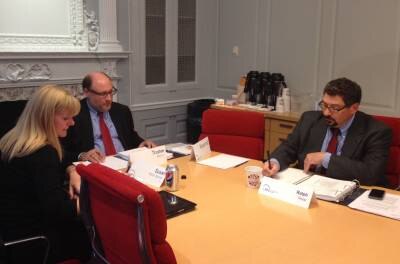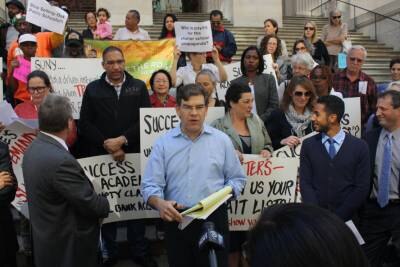The city’s charter school sector, and its largest charter-school network, got a big boost Wednesday.
A State University of New York committee unanimously approved 17 additional charter schools to open over the next two years, with 14 of the charters going to Success Academy, the city’s largest and most controversial network. The other three charters went to Achievement First, a Brooklyn-based network of schools.
Together, the schools are projected to serve more than 11,700 students, according to proposals for both networks — growth that will have major implications for the de Blasio administration, which is facing new budget and space pressures. Under a new state law, the city is required to find the new schools space inside its own buildings or pay the schools a rent subsidy.
The city hasn’t yet decided where it will place any of the planned schools, and the administration has its own plans that will require space in city schools: pre-kindergarten programs and its community schools initiative, which will add health and career services to some struggling schools. Denying the new charter schools public space would mean spending millions on private space under the new law, which was partially spurred by Mayor Bill de Blasio’s decision in March to block three Success Academy schools from moving into public buildings.
“There are hundreds of district school buildings where existing vacancies would make co-location a cost-effective option for siting new schools,” a Success spokesperson said in a statement.
The 17 newly-approved charter schools come after SUNY and the state’s Board of Regents, the state’s other charter authorizer, approved 13 additional charter schools earlier this year. That means just one more charter school can be authorized by SUNY to open in the city under state law. The Board of Regents still has 27 city charters left to approve.
While mostly effusive in their brief remarks about the charter proposals, SUNY officials expressed some concern about the size and oversight of charter management organizations, which now serve similar numbers of students as small school districts. Success Academy’s 14 new schools will add to the 32 that Success currently operates to bring the network to 50 schools—roughly the size of the Savannah, Ga. school district, for example.

“We need to start thinking about how we authorize and monitor and review networks that are this large,” said Joseph Belluck, chair of SUNY’s charter schools committee.
Belluck directed Susan Miller Barker, the director of SUNY’s Charter School Institute, to look into ways SUNY could monitor how charter networks were serving their high-needs students, work more collaboratively with nearby district schools, and replacing students who leave the school—a contested policy known as “backfilling.”
Belluck also took some credit for Success Academy’s recent offer to host a professional development day for district-school principals. Another idea Belluck floated was for networks to share special-education teachers and resources across schools in the same way that districts do. Such a change would require revisions to the state’s charter school law and had encountered opposition from teachers unions in the past.
Miller Barker said that some changes were already underway. She said Success Academy officials told her that they planned to begin replacing students who leave the school at all grades, which would be a dramatic shift from the network’s current policy of only replacing students who leave through third grade.
Critics of Success often cite the network’s backfilling policy as a contributor to its impressive state test scores, since the policy means its elementary schools serve fewer students as they reach tested grades—and many of the students who leave for various reasons might have struggled.

A Success spokesperson confirmed the network was changing its enrollment policies, but would only say that it would be filling empty seats up to fourth grade, up from its current cutoff of third grade, in the 2015-16 year. (A spokesman for SUNY later clarified that Miller Barker misspoke about Success backilling in every grade).
Meanwhile, in an illustration of how divisive charter schools remain in the city, and how divisive Success Academy is in particular, parents and City Councilmembers stood outside the Department of Education headquarters on Wednesday to protest SUNY’s approvals. There is too little oversight of how charter schools spend their money, they said, and traditional public schools that are co-located with charter schools remain underfunded, with arts programs cut, occupational therapy sessions held in hallways, and science labs scaled down. They also pointed to enrollment data from SUNY showing that 13 existing Success Academy schools were under-enrolled last October, including three by more than 27 percent. (The Brooklyn parents group, WAGPOPS, compared charter enrollment targets obtained from SUNY via a FOIA request with enrollment figures from education department space-sharing documents.)
“We have a right to say what happens with taxpayer dollars,” said Tesa Wilson, a parent who heads District 14’s Community Education Council.
“This is about oversight. This is about accountability,” said Daniel Dromm, chair of the City Council’s education committee. “This is about creating better public schools in New York City.”
Jessica Glazer contributed reporting.
Correction: This story has been updated to reflect that the approvals will bring Success Academy to 50 schools.

